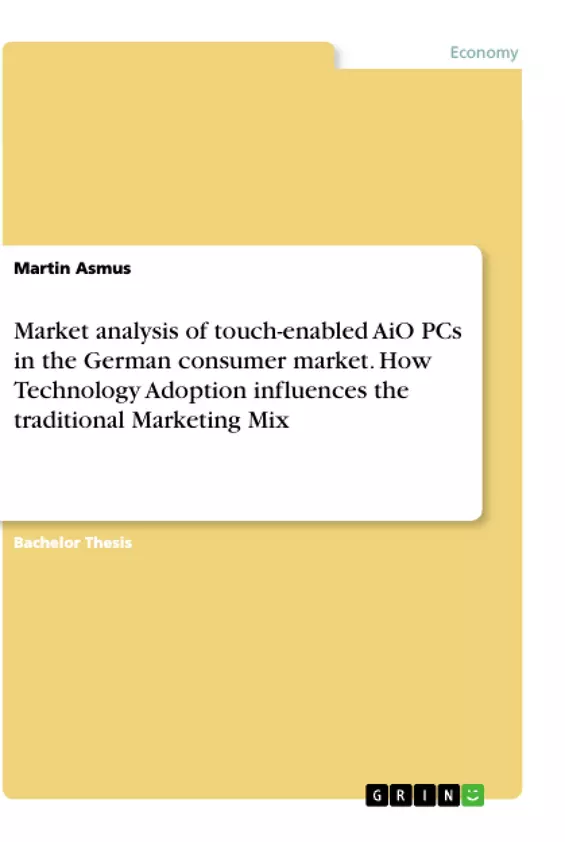The subject of this work is to give the reader a detailed overview of the current state of the All-in-One PC market for German consumers. The author questions the public perception of All-in-One PCs in the consumers’ minds. Also, the use and acceptance of touch technology for large screen devices is studied. The purpose of this thesis is to analyze how All-in-One PCs can be effectively marketed in an industry that focuses more and more on mobile computing devices.
In the first part an introduction to the desktop PC market and touch screen technology is given. Then, the theoretic concepts of strategic marketing and techno-ready marketing are discussed within a hypercompetitive and innovation-driven industry. The research part consists of a thorough market and competitive analysis of the All-in-One PC market in Germany. In addition, a conducted opinion survey provides valuable insights from a consumer perspective. The findings of the research are afterwards evaluated and interpreted. Thereupon, the originally outlined problem is reassessed and recommendations are given to HP Germany, the cooperating company of this thesis, on how to adjust respective marketing activities for technological innovative products. Finally, a market outlook weighs the opportunities and threats that lie ahead for the product category All-in-One PC. The last chapter summarizes the key learnings of this thesis, how it benefits the cooperating company and ends with a brief personal assessment about the topic by the author.
The results of the market analysis suggest that HP can improve its brand preference and that people are not aware enough of the product All-in-One PC and its features and benefits. A more educative marketing approach is proposed by adding a 5th P – for pedagogy – to the traditional marketing mix.
Inhaltsverzeichnis (Table of Contents)
- INTRODUCTION
- Given problem and purpose of the thesis
- Motivation and structure of the thesis
- Introduction to the Hewlett-Packard Company
- Company overview
- Personal Systems Group
- Recent organizational realignment
- Product range
- Introduction to the desktop PC market and touch technology
- Definitions and product characteristics
- Desktop PC market
- Touch technology
- HYPERCOMPETITIVE AND INNOVATION-DRIVEN MARKETING
- Strategic Marketing
- Basics and Definitions
- Strategy
- Marketing
- Marketing Myopia
- Organizational Strategy
- Strategic Marketing
- Strategic Considerations
- Strategic Leadership and Positioning
- Strategic Growth
- Marketing Mix
- Product
- Price
- Place
- Promotion
- Comparison of the 4 P and 7 P Marketing Mix
- Hypercompetition
- Definition and Characteristics
- The New 7-S’s
- Hypercompetition in the IT industry
- Consumer Behavior and Consumer Analysis
- Technology and Innovation
- Invention vs. Innovation
- Techno-ready Marketing
- Adoption and Diffusion
- Technology Readiness
- The Five Types of Technology Customers
- Theory Chapter Summary and Transition to Research Part
- ANALYSIS OF THE CURRENT SITUATION
- Preliminary Market Segmentation
- Geographic Segmentation and Comparison (EMEA vs. Germany)
- Customer Segmentation (Business vs. Consumer)
- Product Segmentation and Differentiation (Standard Desktops vs. AiO Desktops)
- Price Segmentation
- Current Market Analysis
- Actual Market Share (Volume / Value)
- Market Share Development (Volume / Value)
- Price Band Analysis
- Assessment of Competitive Situation
- Competitor Analysis
- Apple
- Lenovo
- Acer
- Toshiba and new market entrants
- HP’s AiO product portfolio
- Strategic Objectives
- OPINION RESEARCH
- Methodology of Research
- Research Objectives
- Survey Method and Questionnaire Design
- Survey Distribution and Population
- Survey Constraints
- Survey Results
- RESEARCH EVALUATION AND RECOMMENDATIONS
- Interpretation of Findings
- Reassessment of original Problem Statement
- Influence of Technology Adoption towards Marketing Mix
- Proposed adjustments and recommendations
- Market Outlook
- CONCLUSION AND FINAL THOUGHTS
- Conclusion
- Benefits of the thesis for HP & PSG Category Germany
- Personal Assessment
Zielsetzung und Themenschwerpunkte (Objectives and Key Themes)
This thesis examines the current state of the All-in-One (AiO) PC market for German consumers, focusing on the public perception of AiO PCs and the use and acceptance of touch technology for these devices. It analyzes how AiO PCs can be effectively marketed in an industry increasingly focused on mobile computing devices.
- Market analysis of touch-enabled All-in-One PCs in the German consumer market
- Public perception of All-in-One PCs
- Use and acceptance of touch technology for large-screen devices
- Influence of technology adoption on the traditional marketing mix
- Strategic marketing in a hypercompetitive and innovation-driven environment
Zusammenfassung der Kapitel (Chapter Summaries)
The thesis starts with an introduction to the desktop PC market and touch screen technology, followed by a discussion of theoretical concepts of strategic marketing and techno-ready marketing in a hypercompetitive and innovation-driven industry. The research part features a market and competitive analysis of the AiO PC market in Germany and includes a conducted opinion survey providing insights from a consumer perspective. The findings are evaluated and interpreted, leading to recommendations for HP Germany on how to adjust their marketing activities for innovative products. Finally, a market outlook explores the opportunities and threats for the AiO PC product category.
Schlüsselwörter (Keywords)
This thesis focuses on the key themes of touch-enabled All-in-One PCs, technology adoption, consumer behavior, hypercompetition, innovation, strategic marketing, and market analysis in the German consumer market. It examines the role of factors like brand perception, product awareness, and pricing in influencing market share and consumer preferences within the AiO PC industry.
- Citar trabajo
- Martin Asmus (Autor), 2012, Market analysis of touch-enabled AiO PCs in the German consumer market. How Technology Adoption influences the traditional Marketing Mix, Múnich, GRIN Verlag, https://www.grin.com/document/464150



